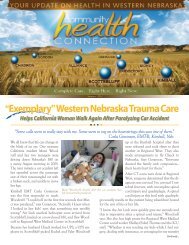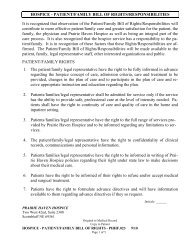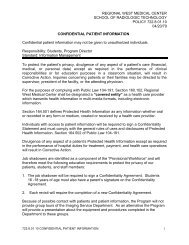2010 Annual Report - Regional West Medical Center
2010 Annual Report - Regional West Medical Center
2010 Annual Report - Regional West Medical Center
You also want an ePaper? Increase the reach of your titles
YUMPU automatically turns print PDFs into web optimized ePapers that Google loves.
IntroductionBreast cancer is the focus of this year’s annual report.Worldwide, breast cancer is the most frequently diagnosedlife-threatening cancer in women and the leading causeof cancer death among women. Over the past 25 years,breast cancer incidence rates have risen globally, with thehighest rates in western countries. Reasons for this trendinclude change in reproductive patterns, increased screening,dietary changes, and decreased activity.Although breast cancer incidence is on the rise globally,breast cancer mortality has been decreasing, especiallyin industrialized countries. The 2002 international femalebreast cancer incidence rates varied by more than 25-fold,ranging from 3.9 cases per 100,000 in Mozambique to101.1 cases per 100,000 in the United States. In 2008, theAmerican Cancer Society (ACS) estimated there were nearly1.4 million new cases of invasive breast cancer worldwide.In the United States, approximately 207,090 new cases offemale invasive breast cancer were predicted to occur in<strong>2010</strong>, along with 1,970 cases in men. In addition to invasivebreast cancer, 54,010 new cases of in situ breastcancer were expected to occur among women, of whichapproximately 85 percent were expected to be ductal carcinomain situ (DCIS).After two decades of increasing incidence rates, the numberof new female breast cancers decreased by 2.2 percentper year from 1999 to 2005. This decrease is thoughtto reflect reduced use of hormone replacement therapy(HRT) following the publication of the Women’s Health Initiativesfindings in 2002, which linked HRT use to an increasedrisk of heart disease and breast cancer. Rates ofDCIS have stabilized since 2000.The current lifetime risk of breast cancer in the US isestimated at 12.7 percent for all women, 13.3 percentfor non-Hispanic whites, and 9.98 percent for blackwomen. Overall, the annual incidence rates in blackwomen (119.4/100,000) and Hispanic/Latina women(89.9/100,000) have been stable since the early 1990s,and they are lower than the annual incidence of breastcancer in white women (141.1/100,000). However, blackwomen are more likely than white women to be diagnosedwith larger, advanced-stage tumors (>5 cm).Many early breast carcinomas may be asymptomatic; painor discomfort is not usually a symptom of breast cancer.Breast cancer is often first detected as an abnormality ona mammogram before it is felt by the patient or health careprovider. The general approach to evaluation of breast cancerhas become formalized as triple assessment: clinicalexamination, imaging (usually mammography and/or ultrasonography),and needle biopsy. Surgery is consideredprimary treatment for breast cancer. Many patients withearly-stage breast cancer are cured with surgery alone.Increased public awareness and improved screening haveled to earlier diagnosis, at stages amenable to completesurgical resection and curative therapies. Consequently,survival rates for breast cancer have improved significantly,particularly in younger women.Adjuvant treatment of breast cancer is designed to treatmicrometastatic disease, or breast cancer cells that haveescaped the breast and regional lymph nodes but whichhave not yet had an established identifiable metastasis.Depending on the model of risk reduction, adjuvant therapyhas been estimated to be responsible for 35-72 percentof the reduction in mortality rate. Over the last twodecades, breast cancer research has led to extraordinaryprogress in our understanding of the disease, resulting inmore efficient and less toxic treatments.<strong>Regional</strong> <strong>West</strong>’s cancer treatment program is committedto early diagnosis of breast cancer, advanced treatmentregimens, and aggressive prevention strategies. Our teamof professionals is dedicated to offering `best practices’and compassionate care to western Nebraska and surroundingcommunities. We could not do this without thehelp of the tireless effort of physicians, nurses, radiationtherapists, social workers, nutritionists, and support staff.Carol Willis, MDChairman, Cancer CommitteeReferences:http://emedicine.medscape.com/article/1947145-overview#a01562
















